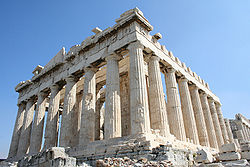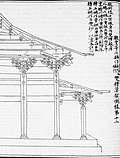Architecture
Architecture is the process of designing structures and buildings. It uses both art and engineering. Examples include houses, churches, hotels, office buildings, roads, tunnels and bridges.[1]
Architecture is the profession of an architect. Usually, a person must study at an institution of higher education (university) to become an architect.[2] There were architects long before there was higher education. They learnt by being an apprentice to an established architect.
Architecture can do small designs,[3] such as for a garage, or large designs, such as for a whole new town. The capital cities of Brasília,[4] and Canberra were designed. Architects often work with structural engineers to make structurally sound buildings.
History
In the past, people built huts and wood houses to protect themselves from the weather. For safety, they were often close together. Great civilizations like the Ancient Egyptians built large temples and structures, like the Great Pyramids of Giza. The Ancient Greeks and Romans made what we now call "Classical Architecture". The Romans, working over 2000 years ago, copied the arch from the Etruscans, who copied it from the Mesopotamians.[5][6]

Classical architecture was formal, and it always obeyed laws. It used symmetry, which really means, and it used proportion between shapes. The Golden Mean was a rule which said, (to put it simply) if you are making a room, or any other thing, it will work best if you always make the long side 1.6 times as long as the short side.[7] There are many 'laws' in classical architecture, like how high the middle of an arched bridge needs to be (which depends on how wide the bridge needs to be). These laws were learned from thousands of years of experience and they are often used today. However, today more notice is taken of specific facts, such as what wind speeds occur once or twice in a century. Several bridges have blown down because that was not properly taken into consideration.
In some parts of the world, like India, the architecture is famous for carving the stone on temples and palaces. Different architectural styles occur in China, Japan, Southeast Asia, Africa, Mexico, and Central and South America.
Architects in Western Europe in the Middle Ages made Romanesque architecture, then Gothic architecture. Gothic buildings have tall, pointed windows and arches. Many churches have Gothic architecture. Castles were also built at this time. In Eastern Europe, churches usually had domes. People added their own ideas and decoration to the Classical Architecture of the past. The Renaissance brought a return to classical ideas.
In the late 18th century with the Industrial Revolution, people began to invent machines to make things quickly and cheaply. Many factories and mills were built during, or after this revolution. Decades later, in the Victorian era, architects like George Fowler Jones and Decimus Burton still followed the Gothic style to build new churches. Up to this point, buildings were limited in size and style by the strength of the wood and masonry used to construct them. Gothic cathedrals were among the largest buildings because the gothic arch when combined with buttresses allowed stone buildings to be built taller. For example, the cathedral in Ulm, Germany is over 500 feet tall. However, building with stone has its limits, and building too tall could result in collapse. This happened to the Beauvais Cathedral, which was never completed.
Towards the end of the 19th Century with a second Industrial Revolution, steel became much cheaper. Architects began to use inventions like metal girders and reinforced concrete to build. An example is the Eiffel Tower in Paris. Buildings can now be built taller than ever before. We call them skyscrapers. This new technology has made us free from traditional limitations, and because of the new possibilities presented by these materials, many traditional methods of construction and ideas about style were reevaluated, replaced, or abandoned. Cheap, strong glass soon brought transparent exterior walls, especially for office buildings.
Modernism is the name for the architectural style which developed because of these new building technologies, and its beginnings can been seen as early as 1890. Modernism can also refer to a specific group of architects and buildings from the early to late 20th century, and so may not be the proper term to use for many building built since then, which are sometimes called "post-modern".
Many of the world's greatest structures were built by modern-day architects such as Frank Lloyd Wright; Sir Hugh Casson; Norman Foster; I. M. Pei; Adrian Smith; Edward Durell Stone; Frank Gehry; Fazlur Khan; Gottfried Böhm; and Bruce Graham.
Architecture Media
In adding the dome to the Florence Cathedral (Italy) in the early 15th century, the architect Filippo Brunelleschi not only transformed the building and the city, but also the role and status of the architect.
Bauhaus building (Germany). The Bauhaus style co-started modernist architecture.
Illustration of bracket arm clusters containing cantilevers from Yingzao Fashi, a text on architecture by Li Jue (1065–1110)
Plan of the second floor (attic storey) of the Hôtel de Brionne in Paris – 1734.
The National Congress of Brazil, designed by Oscar Niemeyer
Stourhead in Wiltshire, England, designed by Henry Hoare (1705–1785)
In Norway: wood and elevated-level
In Lesotho: rondavel stones
Related pages
References
- ↑ Architecture. Encyclopedia Britannica. Retrieved 27 October 2017. [1]
- ↑ "Becoming an architect". www.architecture.com. Archived from the original on 2009-02-28. Retrieved 2009-03-25.
- ↑ Cole, Emily 2002. Architectural details. Ivy Press. ISBN 978-1-78240-169-8
- ↑ "The Brazilian cities Brasília, Paraty and João Pessoa join the UNESCO Creative Cities Network". www.unesco.org. United Nations Educational, Scientific and Cultural Organization. Archived from the original on October 3, 2018. Retrieved 2018-10-03.
- ↑ Risebero, Bill 2018. The story of Western architecture. Bloomsbury. ISBN 978-1-3500-9212-9
- ↑ Jarzombek, Mark 2014. Architecture of first societies: a global perspective. New York: Wiley.
- ↑ Ching, Francis; Jarzombek, Mark & Prakash, Vikram. 2006. A global history of architecture. Wiley.
Other websites
| Wikimedia Commons has media related to Lua error in Module:Commons_link at line 62: attempt to index field 'wikibase' (a nil value).. |














